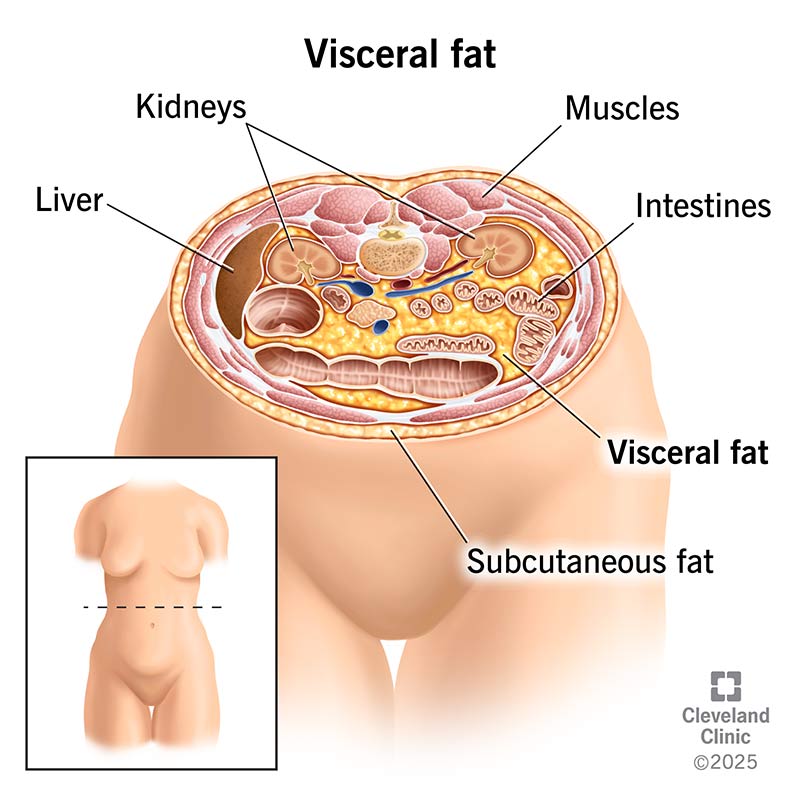Visceral fat is belly fat found deep within your abdominal cavity. It surrounds important organs, including your stomach, liver and intestines. It’s different than subcutaneous fat, which is fat just below your skin. Visceral fat is actually more dangerous to your health. Diet and exercise are the best ways to prevent the buildup of visceral fat.

Visceral fat is a type of body fat that lies deep within your abdominal walls and surrounds your organs. Some levels of visceral fat are healthy and help protect your organs. However, too much visceral fat can be dangerous for your health. Visceral fat is sometimes called “active fat” because it plays an active role in how your body functions. Too much visceral fat can lead to serious health issues such as diabetes, heart disease and stroke.
Advertisement
Cleveland Clinic is a non-profit academic medical center. Advertising on our site helps support our mission. We do not endorse non-Cleveland Clinic products or services. Policy
Subcutaneous fat is fat that’s stored just beneath your skin. It’s the kind that you can pinch between your fingers. Visceral fat is different. Visceral fat is behind your abdominal muscles and can’t be seen. It surrounds your stomach, liver, intestines and other organs. Visceral fat and subcutaneous fat are both types of belly fat.
A growing belly is the most obvious sign of visceral fat, but that can indicate subcutaneous fat as well. Some studies show if you have a potbelly — or are more “apple-shaped” than “pear-shaped” — you may have more visceral fat.
Advertisement
Genetic and environmental factors determine the amount of visceral fat you collect. Genetics determine your body shape and how your body stores visceral fat.
But environmental factors such as diet and exercise play a key role as well. A poor diet with high intake of fatty foods and carbohydrates (sugars) and an inactive lifestyle provide the building blocks for an increase in visceral fat.
However, stress is a factor too. Stress activates a hormone in your body called cortisol. More cortisol activates your body’s “fight-or-flight” response, which triggers the storage of more visceral fat.
Healthcare providers have specific guidelines they use to measure body fat. Visceral fat makes up about 10% of your body fat. You can figure out your visceral fat level by calculating your total body fat percentage and then taking off 10%. If your body fat percentage is higher than recommended, then your visceral fat range will be, too.
There are a few ways you can measure your body fat:
Advertisement
The best way to lose visceral fat is by maintaining a healthy lifestyle. You can lower your visceral fat level by focusing on the same diet and exercise plans you would to help you lose weight and lower your total body fat. Ways to reduce visceral fat include:
It’s important to see your healthcare provider regularly. They can track your body fat percentage, including your visceral fat. If you measure your body fat at home and your measurements are higher than recommended, make an appointment to see your provider. They can talk to you about your health risks and recommend a diet and exercise plan that’ll work for you.
The normal visceral fat range should be about 10% of your body fat. You can figure out your visceral fat level by calculating your total body fat percentage and then taking off 10%. If your body fat percentage is higher than recommended, then your visceral fat range will be too.
Visceral fat is actually easier to lose than subcutaneous fat. This is because it metabolizes quicker and your body can get rid of it as sweat or pee. If you start regularly exercising and eating a healthy diet, you should start to see results in two to three months.
The best way to lose visceral fat is by maintaining a healthy lifestyle. You can lower your visceral fat level by focusing on the same diet and exercise plans you would to help you lose weight and lower your total body fat. Ways to reduce visceral fat include exercising, eating a healthy diet, intermittent fasting, getting more sleep, reducing stress and limiting alcohol.
You should try to limit trans fats, refined sugars, sodium and processed foods. Trans fats are artificial fats that can increase your storage of visceral fat. Baked goods, processed foods, fried foods and some dairy contain trans fats. You should also limit soda, candy and other foods sweetened with partially hydrogenated oils or high-fructose corn syrup.
Yes, too much visceral fat can limit visualization of your organs during intra-abdominal surgery. This can limit the possibility to complete surgeries on a minimally invasive approach.
A note from Cleveland Clinic
You might not be able to see visceral fat, but that doesn’t mean you shouldn’t worry about it. Too much visceral fat can have harmful effects on your health. Fortunately, visceral fat is actually easier to lose than visible subcutaneous fat. By maintaining a healthy diet and keeping up with regular exercise, you should be able to prevent visceral fat from building up in your abdominal cavity. If you suspect you may have too much visceral fat in your belly, talk to your healthcare provider. They can talk to you about your health risks and recommend a diet and exercise plan that’ll work for you.
Last reviewed on 09/12/2022.
Learn more about the Health Library and our editorial process.
Advertisement
Cleveland Clinic is a non-profit academic medical center. Advertising on our site helps support our mission. We do not endorse non-Cleveland Clinic products or services. Policy